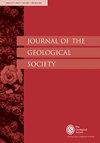延伸-旋转环境中岩浆活动和地壳继承的时空分布:南阿普塞尼山脉中新世和第四纪岩浆活动的最新地质年代学
IF 3
3区 地球科学
Q2 GEOSCIENCES, MULTIDISCIPLINARY
引用次数: 0
摘要
在新近纪和第四纪期间,罗马尼亚南阿普塞尼山(South Apuseni Mountains)活跃着具有弧状特征的岩浆活动。迄今为止,年代学框架主要局限于 K-Ar 日期。我们展示了来自 8 个不同新生代火山-侵入复合体以及侏罗纪和白垩纪熔岩流的次火山岩和火山岩(N=20)新测定的 LA-ICP-MS U-Pb 锆石年龄数据。我们的研究结果表明,岩浆年龄介于约14至约7Ma之间,而碱性侵入体Uroi的发生时间要晚得多,约为1.5Ma。对南阿普塞尼山脉古地磁旋转时间轴的修订表明,阿普塞尼山脉大部分垂直轴顺时针旋转(54.4° ± 10.7°)发生在大约14至11Ma之间,这是大部分岩浆喷出的年龄区间。异晶锆石的年代显示,各个火山侵入复合体之间的年代群存在差异。二叠三叠纪的年龄群几乎无处不在,这表明基底二叠三叠纪火成岩比以前认为的更为广泛,或者它们在新近纪岩浆的生成过程中发挥了重要作用。然而,观测到的其他年龄群,如三叠纪或古近纪,在已知的地质记录中没有明确的对应关系,表明存在与新近纪岩浆相互作用的隐含成分。 补充材料:https://doi.org/10.6084/m9.figshare.c.6951429本文章由计算机程序翻译,如有差异,请以英文原文为准。
Spatio-temporal distribution of magmatism and crustal inheritance within an extensional-rotational environment: An updated geochronology of the Miocene & Quaternary magmatism of the South Apuseni Mountains
Magmatism with arc-like features, formed in extensional settings, was active in the South Apuseni Mountains, Romania, during the Neogene and Quaternary periods. To date the chronological framework is primarily restricted to K-Ar dates. We present newly determined LA-ICP-MS U-Pb zircon age data for subvolcanic and volcanic rocks (N=20) from 8 different Cenozoic volcanic-intrusive complexes and from Jurassic and Cretaceous lava flows. Our results support magmatic ages between c. 14 to c. 7 Ma, with Uroi, an alkaline intrusion, occurring significantly later at c. 1.5 Ma. Revising the timeline for the South Apuseni Mountains paleomagnetic rotations shows that most of the vertical-axis clockwise rotation of the Apuseni Mountains (54.4° ± 10.7°) took place between approximately 14 and 11 Ma, the age interval when the majority of magmas were emplaced. Xenocrystic zircon dates exhibit differences in age populations between individual volcanic-intrusive complexes. A Permo-Triassic population is almost ubiquitous, indicating that basement Permo-Triassic igneous rocks are more widespread than previously thought or that they were significantly involved in the generation of Neogene magmas. However, other observed age populations, such as Triassic or Paleogene have no clear correspondence in the known geological record, indicating the presence of a cryptic component interacting with Neogene magmas.
Supplementary material:
https://doi.org/10.6084/m9.figshare.c.6951429
求助全文
通过发布文献求助,成功后即可免费获取论文全文。
去求助
来源期刊

Journal of the Geological Society
地学-地球科学综合
CiteScore
6.00
自引率
3.70%
发文量
68
审稿时长
6-12 weeks
期刊介绍:
Journal of the Geological Society (JGS) is owned and published by the Geological Society of London.
JGS publishes topical, high-quality recent research across the full range of Earth Sciences. Papers are interdisciplinary in nature and emphasize the development of an understanding of fundamental geological processes. Broad interest articles that refer to regional studies, but which extend beyond their geographical context are also welcomed.
Each year JGS presents the ‘JGS Early Career Award'' for papers published in the journal, which rewards the writing of well-written, exciting papers from early career geologists.
The journal publishes research and invited review articles, discussion papers and thematic sets.
 求助内容:
求助内容: 应助结果提醒方式:
应助结果提醒方式:


